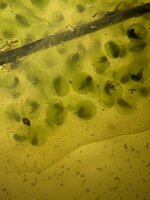Hello! Long time reader, first time poster. I was able to save a cluster of spotted salamander eggs from a drainage pond that is going to be emptied due to construction any day now. I've been doing a ton of reading (this thread was very helpful:
Spotted Salamander Eggs/Larvae Questions!), but I am uncertain what temperature I should be keeping the water at.
Currently they are in an unheated basement room at about 50 degrees F, I have another room that's about 60F and the rest of the house is about 70F. They are in a plastic tub with a bubbler and some plants at the moment, I've been doing water changes pretty often.
Thanks!
Everyone has made some good points on this thread so far. I have no leg to stand on as I, too, am guilty of having a heart and probably interfering with the natural order of things as a result. However, if that pool is about to be wrecked then I really don't see how it's the fault of the parent salamanders and I don't blame you for wanting to save them.
At the risk of being roasted by other posters on this thread, I rescued a small clutch of yellow spotted salamander eggs two years ago after witnessing someone's dog trample through a woodland pool and crush a bunch of them. I then decided to hatch them out before returning them to the pool (which I did as soon as they hatched). I didn't do half of what you're doing for the ones you rescued, yet 95% of them hatched and were perfectly healthy. (It's expected that not all of them will hatch.)
The vernal/woodland pools in my area are in deep shade, where the daytime temps never really get above 60° until mid-May. So, if the eggs in your clutch are developing at 50° then I think you're doing fine. Like others have said, they'll develop more slowly at cooler temps and more quickly at warmer ones. I kept mine at around 60°.
It is important to note that spotted salamanders don't do well in higher temps in general at any life stage. I think their max is like 75° or so? Either way, it will take a few weeks for them to hatch so don't worry if it takes a little while. It's cool to watch as they develop from little black dots into little black commas, then wiggly little black commas, lol.
The only thing I'm not sure about is the bubbler. I can't explain why but it doesn't feel like a great idea, if that makes sense? Maybe because vernal pools do not have flowing water. Or, rather, they have an inlet but not an outlet, so there's not much of a current. I wonder if the bubbler would disturb the clutch in any way as a result.
Also, there's a type of green algae that should develop with the eggs that is important for them and I'm concerned that the bubbler might interfere with that.
Thank you for caring enough to try to save them. Most people don't notice or care.
Edit to add: here's a thread that I found extremely helpful:
Spotted Salamander Eggs/Larvae Questions!
